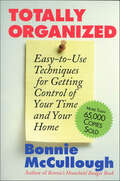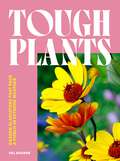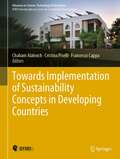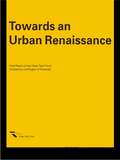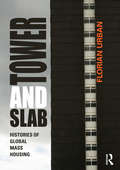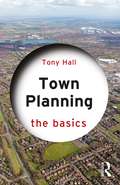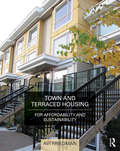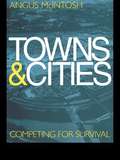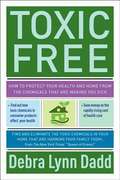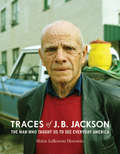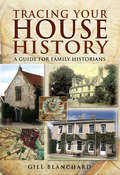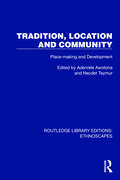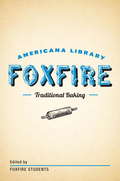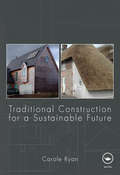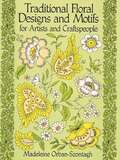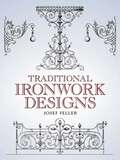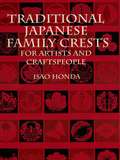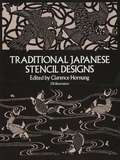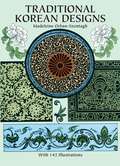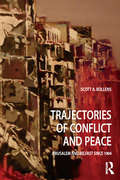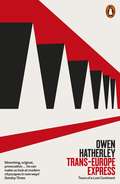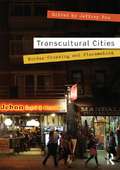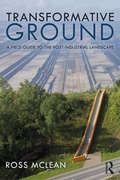- Table View
- List View
Totally Organized: Easy-to-Use Techniques for Getting Control of Your Time and Your Home
by Bonnie McCulloughGetting organized is one of the biggest challenges in any home today. Pressed for time and bogged down by papers, receipts, household items, and an endless stream of junk mail, Americans need expert ways to get an stay on top of it all. Expert organizer Bonnie McCullough has the answers. In this clear, practical guide, she explains how to:--Take control of household tasks by using a planner, making lists, and setting priorities.--Gain more free time by establishing routines and planning ahead.--Create more space in the kitchen, closets, and elsewhere.--Setup a simple, easy-to-use home-filing system.--Get kids, spouses, and roommates motivated to help keep the household organized.--Establish and stick to a household budget.--Simplify holidays and gift giving.--Work smarter, not harder--when tackling housework, paperwork, and all the little things that drain time and energy from our lives.
Tough Plants: Garden gladiators that pack a punch in extreme weather
by Val BourneA stylish and modern guide to plants that flourish in the extreme weather conditions that have become the new norm.There's nothing more soul-destroying than cultivating your beloved garden with beautiful plants, only to see them die a death from heatwave, frostbite or flooding. In extreme weather, the go-to plants of the past are no longer tough enough to survive and thrive. Enter Tough Plants: 40 of the most irrepressible species that will flourish whatever the weather.With species from across the world, expert advice on planting and garden structure, five perfect partners for each entry and multiple variations for the ultimate garden inspiration, this book is a stylish, practical guide to plants that can literally weather the storm.
Tough Plants: Garden gladiators that pack a punch in extreme weather
by Val BourneA stylish and modern guide to plants that flourish in the extreme weather conditions that have become the new norm.There's nothing more soul-destroying than cultivating your beloved garden with beautiful plants, only to see them die a death from heatwave, frostbite or flooding. In extreme weather, the go-to plants of the past are no longer tough enough to survive and thrive. Enter Tough Plants: 40 of the most irrepressible species that will flourish whatever the weather.With species from across the world, expert advice on planting and garden structure, five perfect partners for each entry and multiple variations for the ultimate garden inspiration, this book is a stylish, practical guide to plants that can literally weather the storm.
Towards Implementation of Sustainability Concepts in Developing Countries (Advances in Science, Technology & Innovation)
by Chaham Alalouch Cristina Piselli Francesco CappaThis book focuses on sustainability concepts in architecture and urban design, environmental issues, and natural resources. Today it has become essential to reduce carbon emissions, protect habitats, and preserve the delicate ecosystems of our planet. Accordingly, sustainable development has to be improved by decreasing the consumption of non-renewable resources, in order to help nature replenish itself.Further, it highlights the efforts that have been made by architects, environmentalists, engineers, students, planners and everyone in between in order to improve sustainability in various developing communities and countries.
Towards an Urban Renaissance
by The Urban Task ForceThe Urban Task Force, headed by Lord Rogers, one of the UK's leading architects, was established by the Department of Environment, Transport and Regions (DETR) to stimulate debate about our urban environment and to identify ways of creating urban areas in direct response to people's needs and aspirations. Their findings, conclusions and recommendations were presented in a final report to Government Ministers in Summer 1999 and form the basis of this important new illustrated book.
Tower and Slab: Histories of Global Mass Housing
by Florian UrbanTower and Slab looks at the contradictory history of the modernist mass housing block - home to millions of city dwellers around the world. Few urban forms have roused as much controversy. While in the United States decades-long criticism caused the demolition of most mass housing projects for the poor, in the booming metropolises of Shanghai and Mumbai remarkably similar developments are being built for the wealthy middle class. While on the surface the modernist apartment block appears universal, it is in fact diverse in its significance and connotations as its many different cultural contexts. Florian Urban studies the history of mass housing in seven narratives: Chicago, Paris, Berlin, Brasilia, Mumbai, Moscow, and Shanghai. Investigating the complex interactions between city planning and social history, Tower and Slab shows how the modernist vision to house the masses in serial blocks succeeded in certain contexts and failed in others. Success and failure, in this respect, refers not only to the original goals – to solve the housing crisis and provide modern standards for the entire society – but equally to changing significance of the housing blocks within the respective societies and their perception by architects, politicians, and inhabitants. These differences show that design is not to blame for mass housing’s mixed record of success. The comparison of the apparently similar projects suggests that triumph or disaster does not depend on a single variable but rather on a complex formula that includes not only form, but also social composition, location within the city, effective maintenance, and a variety of cultural, social, and political factors.
Town Planning: The Basics (The Basics)
by Tony HallThe planning of urban and rural areas requires thinking about where people will live, work, play, study, shop and how they will get about the place, and to devise strategies for long time periods. Town Planning: The Basics provides a general introduction to the components of urban areas, including housing, transportation and infrastructure, and health and environment, showing how appropriate policies can be developed. Explaining planning activity at different scales of operation, this book distinguishes between the "big stuff", the grand strategy for providing homes, jobs and infrastructure; the "medium stuff", the design and location of development; and the "small stuff" affecting mainly small sites and individual households. Planning as an activity is part of a complex web stretching way beyond the planning office, and this book provides an overview of the many components needed to create a successful town. It is invaluable to anyone with an interest in planning, from students learning about the subject for the first time to graduates thinking about embarking on a career in planning, to local councillors on planning committees and community boards.
Town and Terraced Housing: For Affordability and Sustainability
by Avi FriedmanRecent societal changes have brought about renewed interest from architects, town planners, housing officials and the public in terraces and townhouses. The small footprint that this style of house occupies allows a sustainable high density approach to habitation, slowing sprawl and creating energy-efficient affordable living. Townhouses have been used for hundreds of years, and their evolution is covered from their inception right up to the present day. With the changing demographics of buyers in mind, Avi Friedman details how the design of these houses can be adapted to keep-up with contemporary needs. Friedman uses a systematic approach to cover the many facets of townhouses from interior design and construction methods, to urban planning issues like adjusting to the site’s natural conditions, street configurations and open spaces. This approach creates a book which will be a valuable resource for those involved in the planning, design and creation of terraced and town houses. Over 150 detailed diagrams and plans, and eighty photos, illustrate the essential elements of this style of housing. In the final chapter, lessons learnt throughout the book are draw together in ten broad ranging case study projects, showing how the various aspects can be put into practice.
Towns and Cities: Competing for survival
by Angus McIntosh Dr Angus McintoshThe last fifty years have seen dramatic changes in towns and cities. People have moved out of central urban areas, retailing has moved out of towns and jobs have also declined in city centres, particularly with the growth of business and science parks. With the continuing decline of the manufacturing sector and the re-shaping of employment in the service sector, a new force will increasingly dominate urban development, the meritocratic elite. The meritocratic elite are those able to develop and use information technology to generate productivity and wealth. Where they wish to live will increasingly influence future urban development.Towns and Cities - Competing for survival suggests that as public and private corporations continue to downsize, outsource and re-engineer themselves, an increasing amount of expenditure and employment growth will lie with the leisure sector. Herein lies one of the solutions to the decline of towns and cities.Town planners and economists have continually displayed a lack of understanding of these developments and have not anticipated the forces which cause urban change. As the global econonmy, combined with changes in transport and information technology increasingly dominates our lives, local and national governments need a new agenda for the 21st century. If they fail to rise to this challenge many of our town and city centres will continue to decline and may not survive.
Toxic Free
by Dadd Debra LynnFrom the The New York Times'"Queen of Green" comes the ultimate guide for finding and eliminating the toxic chemicals in your home today. There is no longer any question that consumer products contain toxic chemicals harmful to our families. But how do we protect ourselves, and where do we start? In Toxic Free, Debra Lynn Dadd, hailed by The New York Times as the "Queen of Green," discusses the hidden toxic chemicals already present in our homes, their varying degrees of danger, and precise, proven methods for eliminating them from our lives in a cost- effective, environmentally friendly way. Are you suffering from unexplained headaches, fatigue, or depression? Are you worried about the link between chemicals in the home and the rising rate of cancer? Or are you just looking to save money (and the planet in the process)? From tips and do-it-yourself formulas to world-class research and in-depth exploration and explanation, this book provides: a basic understanding of how toxic chemicals in consumer products affect your health; all the tools you need to remove these toxins from your home and body- starting today; and helpful guides on how to immediately save money on home-care products, as well as on the rapidly rising cost of your health care. .
Traces of J. B. Jackson: The Man Who Taught Us to See Everyday America (Midcentury: Architecture, Landscape, Urbanism, and Design)
by Helen L. HorowitzJ. B. Jackson transformed forever how Americans understand their landscape, a concept he defined as land shaped by human presence. In the first major biography of the greatest pioneer in landscape studies, Helen Horowitz shares with us a man who focused on what he regarded as the essential American landscape, the everyday places of the countryside and city, exploring them as texts that reveal important truths about society and culture, present and past. In Jackson’s words, landscape is "history made visible."After a varied life of traveling, writing, sketching, ranch labor, and significant service in army intelligence in World War II, Jackson moved to New Mexico and single-handedly created the magazine Landscape. As it grew under his direction throughout the 1950s and 1960s, Landscape attracted a wide range of contributors. Jackson became a man in demand as a lecturer and, beginning in the late 1960s, he established the field of landscape studies at Berkeley, Harvard, and elsewhere, mentoring many who later became important architects, planners, and scholars. Horowitz brings this singular person to life, revealing how Jackson changed our perception of the landscape and, through friendship as well as his writings, profoundly influenced the lives of many, including her own.
Tracing Your House History: A Guide For Family Historians (Tracing Your Ancestors)
by Gill Blanchard“With its practical slant and focus on demystifying unfamiliar property documents, this is the perfect introduction to tracing a house history.” —Family Tree MagazineAnyone who wants to find out about the history of their house—of their home—needs to read this compact, practical handbook. Whether you live in a manor house or on a planned estate, in a laborer’s cottage, a tied house, a Victorian terrace, a twentieth-century council house or a converted warehouse—this is the book for you. In a series of concise, information-filled chapters, Gill Blanchard shows you how to trace the history of your house or flat, how to gain an insight into the lives of the people who lived in it before you, and how to fit it into the wider history of your neighborhood.A wealth of historical evidence is available in libraries, archives and record offices, in books and online, and this is the ideal introduction to it. Gill Blanchard explores these resources in depth, explains their significance and directs the researcher to the most relevant, and revealing, aspects of them. She makes the research process understandable, accessible and fun, and in the process, she demystifies the sometimes-obscure language and layout of the documents that researchers will come up against.“This book is more than a guide to researching the history of your house, or a house of interest. It is a font of interest if you are seeking to research and understand the social and domestic lives of people and their communities from early times.” —Federation of Family History Societies
Tradition, Location and Community: Place-making and Development (Routledge Library Editions: Ethnoscapes)
by Adenrele Awotona Necdet TeymurOriginally published in 1997, as part of the Ethnoscapes: Current Challenges in the Environmental Social Sciences series, reissued now with a new series introduction, Tradition, Location and Community: Place-making and Development brings together the selected papers of seventeen architects, social scientists and planners. It offers a range of original perspectives on the relationship between the design and habituation of the built environment on the one hand and social and cultural development on the other. As an archival volume, it attempts to present a mixture of cross-disciplinary and cross-cultural perspectives. It explores the view that planning and design (the organization of the physical/built environment) which follow from the rapid transformations wrought by development must respond to, and be based on, the wants and needs of the people affected; that is, it must be in accord with their notions of environmental quality.Divided into two sections. The first section has five chapters which explore the theoretical and conceptual aspects of place-making and development. Section two consists of twelve chapters, each of which presents a case study.
Traditional Baking: The Foxfire Americana Library (2) (The Foxfire Americana Library)
by Inc. Foxfire FundThe Foxfire Americana Library brings you back-to-basics recipes for breads, cornbreads, puddings, cakes, and pies that are just as easily baked on a modern oven as the traditional Appalachian woodstoves where they began. For adventurous cooks, this volume also includes instructions and diagrams on how to build a churn and make your own butter. Recipes include: Corn PoneHush PuppiesRye BreadCracklin' BreadMolasses Sweet Bread Syrup Bread Dried Apple CakeTame Gooseberry Pie Aunt Arie's Recipe for Egg Custard
Traditional Construction for a Sustainable Future
by Carole RyanSince the spread of classical design and construction amongst the upper echolons of British society in the late seventeenth century, traditional construction methods have largely fallen by the wayside. Centuries later, as the construction industry faces up to its environmental responsibilities, this book explores its rich and ancient tradition to provide tried and trusted solutions to modern day construction problems. By way of introduction, the ancient and historical lifestyles that dictated the nature of traditional construction are explored, before focussing on its health and ecological benefits. As well as cultural background, this book includes a detailed scientific description of traditional building materials and their constituents which draws a sharp contrast with modern petrochemical-based materials. The studies of traditional buildings included reveal the sustainability of features such as natural ventilation and breathing walls, and comparisons with modern construction methods show how they could prevent 'sick building syndrome'. The author argues that maintenance for long life, by contrast with the modern concept of life-cycle costing, is at the nub of sustainability and underlies the contribution traditional building construction can make to tackling climate change. Over 250 original photos, and over fifty bespoke diagrams illustrate the features, techniques, and characteristics of traditional construction that could make such a valuable contribution to the industry today. The inclusion of a close study of how these methods relate to British building regulations makes this book a practical guide for construction professionals, as well as an authoritative resource for students and policy-makers.
Traditional Floral Designs and Motifs for Artists and Craftspeople (Dover Pictorial Archive)
by Madeleine Orban-SzontaghRe-create a lovely spray of wild roses that once bloomed in abundance on an early nineteenth-century fabric. Duplicate a lush Persian floral print from a kerchief worn in the waning days of the acien régime. These and dozens of other superb royalty-free designs -- adapted from patterns on antique textiles -- are available now to artists and craftspeople in this attractive collection.A noted artist and surface designer has masterfully rendered nearly 230 designs from French, English, German, Swiss, and Russian textiles of the eighteenth and nineteenth centuries. Featured are profusions of flowers, leaves, sprays, branches, fruits, and birds in a wide variety of formats: clusters, bouquets, single vignettes, and more. Also shown are several full-page motifs with a single large, elaborate flower. Captions supply a brief description, date, and place of origin for the designs on each page.Among the many charming samples are floral and butterfly blockprints from Alsace in France (c. 1790), a Kashmir floral motif from England (1805), an English rose bouquet (1834), berries and flowers from Switzerland (1820), and scores of others.
Traditional Ironwork Designs (Dover Pictorial Archive)
by Josef FellerFrom an exceptional collection of the finest examples of German ironwork comes this rich source of royalty-free images for artists and craftspeople. More than 270 illustrations depict a broad variety of magnificent ironworks from the city of Düsseldorf, with finely rendered examples of the craft ranging from elaborate castle gates to ornate weather vanes.Balustrades, screens, balcony railings, and other decorative ironworks abound in this handsome compilation. Derived from a rare, turn-of-the-century portfolio, these splendid designs offer uncommon glimpses of a rich array of motifs that are sure to inspire and delight designers, architecture enthusiasts, antique lovers, and devotees of vintage ironwork.
Traditional Japanese Family Crests: for Artists and Craftspeople
by Isao HondaOver 1,700 compact, graceful designs -- a traditional part of many Japanese family histories -- are featured in this handsome, versatile collection. Depicting plant, leaf, animal, and fan designs in circular motifs; astronomical images, and more, the authentic, royalty-free crests are ideal for use as spot illustrations in a variety of graphic projects.
Traditional Japanese Stencil Designs (Dover Pictorial Archive)
by Clarence HornungThe demand by artists and craftspeople for visually exciting designs has created renewed interest in traditional Japanese motifs which are ideal for modern decorative and graphic needs.This comprehensive archive presents 276 exquisite Japanese stencil designs, inspired by natural themes and developed to ideographic perfection through the centuries. Sky, seam and land birds, beasts, insects, and countless flora and fauna comprise Japanese design vocabulary.Versatile motifs include clouds, sun, stars, waves, birds, butterflies, dragonflies, fish, and delicate floral and foliate patterns — chrysanthemum, plum and cherry blossoms, bamboo, ivy, wisteria, oak and maple leaves, and much more. You'll also find abstract and geometric designs — circles, squares, diamonds, polygons, stripes, bands, and lattice motifs — as well as fans, wheels, umbrellas, and other man-made objects.
Traditional Korean Designs (Dover Design Library)
by Madeleine Orban-Szontagh142 bold black-and-white line drawings inspired by authentic Korean arts and crafts dating from the 1st through the 19th centuries, ranging from full- and half-page motifs to borders, panels, medallions, and all-over patterns, and from abstract forms to realistic depictions of costumed figures, birds, flowers, and landscapes. Royalty-free.
Trails for the Twenty-First Century: Planning, Design, and Management Manual for Multi-Use Trails
by Kristine Olka Robert Rails to Trails Conservancy Charles Flink David Burwell Robert SearnsCommunities across the country are working to convert unused railway and canal corridors into trails for pedestrians, cyclists, horseback riders, and others, serving the needs of both recreationists and commuters alike. These multi-use trails can play a key role in improving livability, as they offer an innovative means of addressing sprawl, revitalizing urban areas, and reusing degraded lands. Trails for the Twenty-First Century is a step-by-step guide to all aspects of the planning, design, and management of multi-use trails. Originally published in 1993, this completely revised and updated edition offers a wealth of new information including. *discussions of recent regulations and federal programs, including ADA and TEA-21 *recently revised design standards from AASHTO *current research on topics ranging from trail surfacing to conflict resolution *information about designing and building trails in brownfields and other *environmentally troubled landscapes Also included is a new introduction that describes the importance of rail-trails to the sustainable communities movement, and an expanded discussion of maintenance costs. Enhanced with a wealth of illustrations, Trails for the Twenty-First Century provides detailed guidance on topics such as: taking a physical inventory and assessment of a site; involving the public and meeting the needs of adjacent landowners; understanding and complying with existing legislation; designing, managing, and promoting a trail; and where to go for more information. It is the only comprehensive guidebook available for planners, landscape architects, local officials, and community activists interested in creating a multi-use trail.
Trajectories of Conflict and Peace: Jerusalem and Belfast Since 1994 (Planning, History and Environment Series)
by Scott A BollensCreating peace for a city’s intimate enemies is harder than making war. This book is about the trajectories of urban conflict and peace in the politically polarized cities of Jerusalem and Belfast since 1994 – how sometimes there has been hopeful change while at other times debilitating stasis and regression. Based on extensive research, fieldwork, and interviews, Scott Bollens shows how seeking peace in these cities is shaped by the interaction of city-based actors and national elites, and that it is not just a political process, but a social and spatial one that takes place problematically over an extended period. He intertwines academic precision with ethnography and personal narrative to illuminate the complex political and emotional kaleidoscopes of these polarized cities. With hostility and competition among groups defined by ethnic, religious, and nationalistic identity on the increase across the world, this timely investigation contributes to our understanding of today’s fractured cities and nations.
Trans-Europe Express: Tours of a Lost Continent
by Owen Hatherley'A scathing, lively and timely look at the "European city", from one of our most provocative voices on culture and architecture today' Owen JonesA searching, timely account of the condition of contemporary Europe, told through the landscapes of its citiesOver the past twenty years European cities have become the envy of the world: a Kraftwerk Utopia of historic centres, supermodernist concert halls, imaginative public spaces and futuristic egalitarian housing estates which, interconnected by high-speed trains traversing open borders, have a combination of order and pleasure which is exceptionally unusual elsewhere.In Trans-Europe Express, Owen Hatherley sets out to explore the European city across the entire continent, to see what exactly makes it so different to the Anglo-Saxon norm - the unplanned, car-centred, developer-oriented spaces common to the US, Ireland, UK and Australia. Attempting to define the European city, Hatherley finds a continent divided both within the EU and outside it. 'The latest heir to Ruskin.' - Boyd Tonkin, Independent 'Hatherley is the most informed, opinionated and acerbic guide you could wish for.' - Hugh Pearman, Sunday Times 'Can one talk yet of vintage Hatherley? Yes, one can. Here are all the properties that have made him one of the most distinctive writers in England - not just 'architectural writers', but writers full stop: acuity, contrariness, observational rigour, frankness and beautifully wrought prose.' - Jonathan Meades
Transcultural Cities: Border-Crossing and Placemaking
by Jeffrey HouTranscultural Cities uses a framework of transcultural placemaking, cross-disciplinary inquiry and transnational focus to examine a collection of case studies around the world, presented by a multidisciplinary group of scholars and activists in architecture, urban planning, urban studies, art, environmental psychology, geography, political science, and social work. The book addresses the intercultural exchanges as well as the cultural trans-formation that takes place in urban spaces. In doing so, it views cultures not in isolation from each other in today’s diverse urban environments, but as mutually influenced, constituted and transformed. In cities and regions around the globe, migrations of people have continued to shape the makeup and making of neighborhoods, districts, and communities. For instance, in North America, new immigrants have revitalized many of the decaying urban landscapes, creating renewed cultural ambiance and economic networks that transcend borders. In Richmond, BC Canada, an Asian night market has become a major cultural event that draws visitors throughout the region and across the US and Canadian border. Across the Pacific, foreign domestic workers in Hong Kong transform the deserted office district in Central on weekends into a carnivalesque site. While contributing to the multicultural vibes in cities, migration and movements have also resulted in tensions, competition, and clashes of cultures between different ethnic communities, old-timers, newcomers, employees and employers, individuals and institutions. In Transcultural Cities Jeffrey Hou and a cross-disciplinary team of authors argue for a more critical and open approach that sees today’s cities, urban places, and placemaking as vehicles for cross-cultural understanding.
Transformative Ground: A Field Guide to the Post-Industrial Landscape
by Ross McleanAimed at students and instructors, alongside practitioners and researchers, in landscape architecture and its allied disciplinary fields, this book provides the reader with a clear framework of theoretical and practical considerations for interpreting and designing post-industrial landscapes. One of the biggest contemporary challenges currently faced in the profession is how to effectively understand and work with the transformational possibilities of post-industrial landscapes, while negotiating significant spatial challenges, such as degradation and fragmentation. Transformative Ground: A Field Guide to the Post-Industrial Landscape presents a range of theoretical perspectives and practical approaches, offering a broad scope of contemporary design strategies that deal with post-industrial landscapes. Through a series of thematic chapters, allied with precedents from leading design offices, this book identifies how the context of post-industrial landscapes has compelled shifts in fundamental ideas that underpin landscape design. As a richly illustrated account of this transformative ground, this book provides a must-have guide to help you reimagine the post-industrial landscape.
